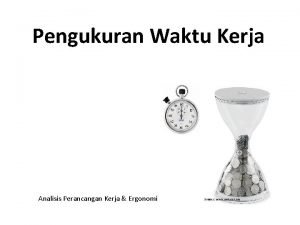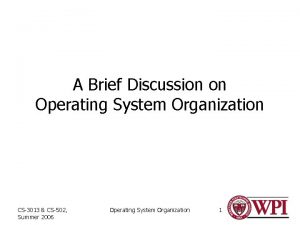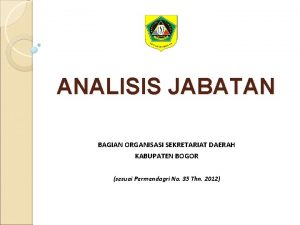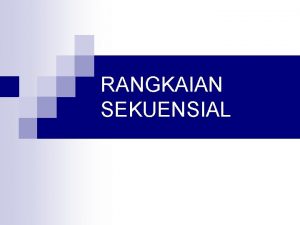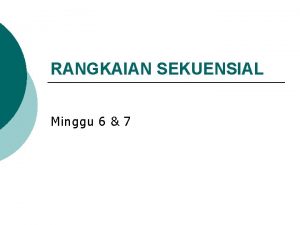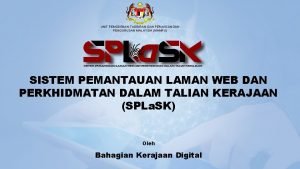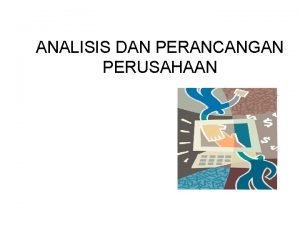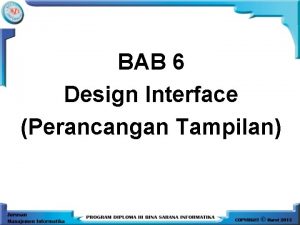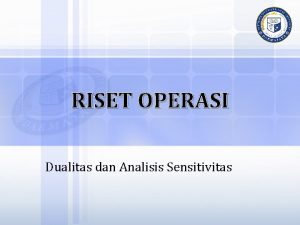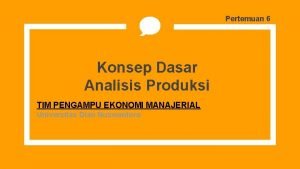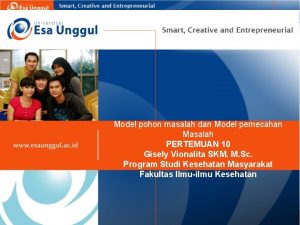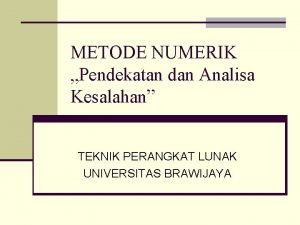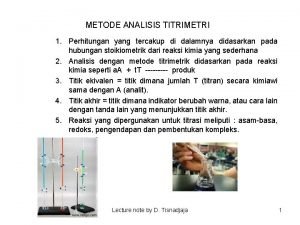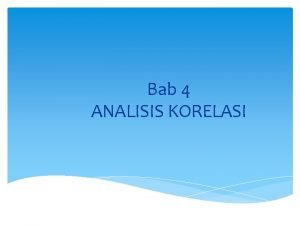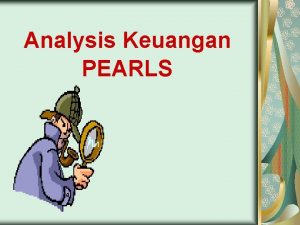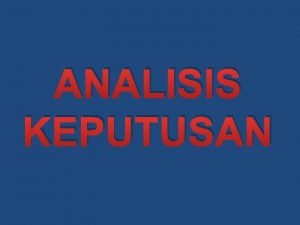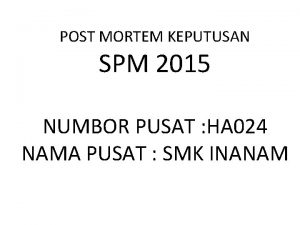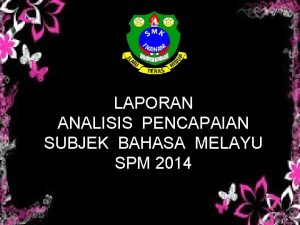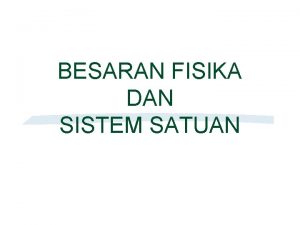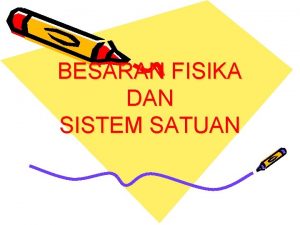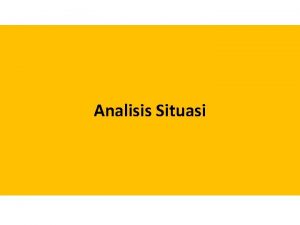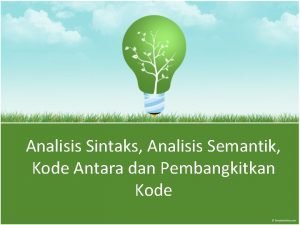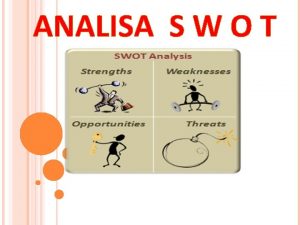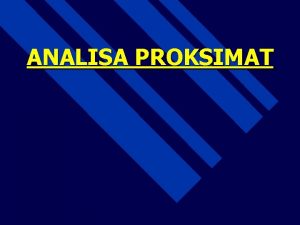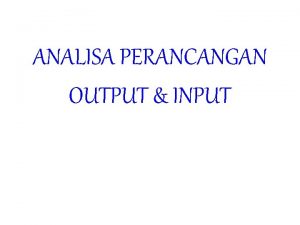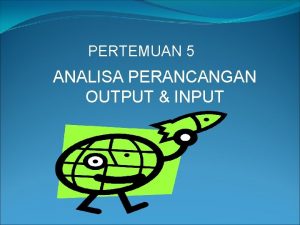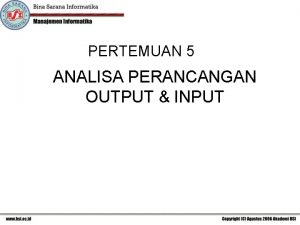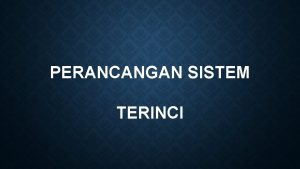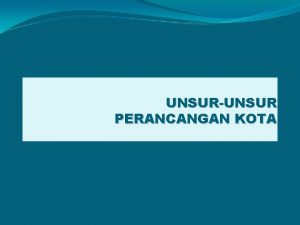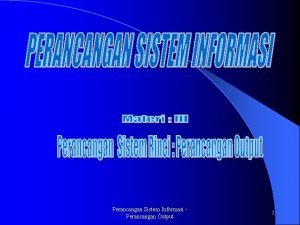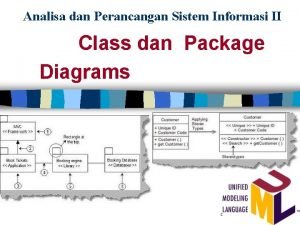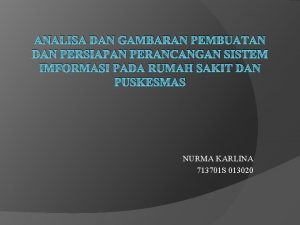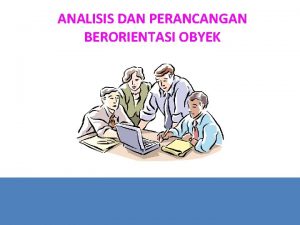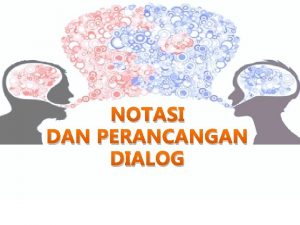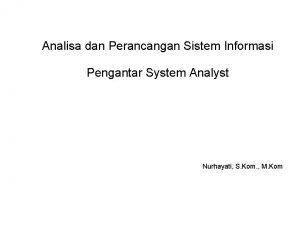System Design Analisa dan Perancangan SI IS 3013





























- Slides: 29

System Design Analisa dan Perancangan SI (IS 3013) 1

Definition & Goal • Also called physical design. • Where systems analysis emphasizes the business problem, systems design emphasizes the technical or implementation concerns of the system. • Goal : – to design a system that both fulfills requirements and will be friendly to user – present clear and complete specification to the computer programmer and technician 2

Design Approaches • Model-Driven – Structured design – Information engineering – Prototyping – Object-oriented • RAD 3

Model-Driven Approaches – Modern Structured Design Model-driven strategy – a system design approach that emphasizes drawing system models to document technical and implementation aspects of a system. Modern structured design – a system design technique that decomposes the system’s processes into manageable components. – Synonyms (although technically inaccurate) are top-down program design and structured programming. – Design in a top-down hierarchy of modules – Easier to implement and maintain (change). – Modules should be highly cohesive • Accomplish one function only – Modules should be loosely coupled • Minimally dependent on one another 12 -4

Structure Chart 12 -5

Model-Driven Approaches – Information Engineering Information engineering (IE) – a model-driven and data-centered, but process-sensitive technique for planning, analyzing, and designing information systems. IE models are pictures that illustrate and synchronize the system’s data and processes. – The primary tool of IE is a data model diagram. 12 -6

Physical Entity Relationship Diagram 12 -7

Model-Driven Approaches – Prototyping Prototype – a small-scale, incomplete, but working sample of a desired system The prototyping approach is an iterative process involving a close working relationship between the designer and the users. Key Benefits: – Active model that end-users can interact with. – Encourages and requires active end-user participation – Endorses philosophy that end-users won’t know what they want until they see it. – Errors can be detected earlier. – Accelerates several phases of the life cycle. – Iteration accommodates end-users who tend to change their minds. 12 -8

Model-Driven Approaches – Prototyping Disadvantages and Pitfalls: – Still need systems analysis phases, but so easy to skip. – Cannot completely substitute a prototype for a paper specification (like architect without a blueprint). – Numerous design issues are not addressed by prototyping. – Scope and complexity of the system can expand out of control. – Can reduce creativity in designs (implementation can drive out analysis). 12 -9

Prototype screen 12 -10

Model-Driven Approaches – Object. Oriented Design Object-oriented design (OOD) techniques are used to refine the object requirements definitions identified earlier during analysis, and to define design specific objects. – Extension of object-oriented analysis – Attempt to eliminate the separation of concerns about data and process. 12 -11

Object-Oriented Design Model 12 -12

Rapid Application Development (RAD) Rapid application development (RAD) – a systems design approach that utilizes structured, prototyping, and JAD techniques to quickly develop systems. – The merger of various structured techniques to accelerate systems development • Data-driven information engineering • Prototyping • Joint application development 12 -13

Joint Application Development (JAD) is a technique that complements other systems analysis and design techniques by emphasizing participative development among system owners, users, designers, and builders. During the JAD sessions for systems design, the systems designer will take on the role of facilitator for possibly several full-day workshops intended to address different design issues and deliverables. 12 -14

Context Of In-House Development Projects (Build) 12 -15

System Design Tasks For In-House Development 12 -16

System Design Tasks For In-House Development (Build) • Task 5. 1 : Design the Application Architecture – Defines the technologies to be used by (and used to build) one, more, or all information systems, in term of the data, process, interface and network components – Designing how the data, process and interfaces are to be distributed among the business location – Revise models – Stakeholder – system user : help address business data, process and location issues – Several different system designer (network specialist, database administrator, application administrator, graph designer, etc) – Deliverable : application architecture 12 -17

System Design Tasks For In-House Development (Build) • Task 5. 2 : Design the System Databases – Develop the corresponding database design specification – Designer must be attentive to designing databases that are adaptable to future requirement and expansion – Designer must analyze how programs will access the data in order to improve performance – Designer must design internal control to ensure proper security and disaster recovery techniques, in case dat is lost or destroyed – Delivearable : database schema 12 -18

System Design Tasks For In-House Development (Build) • Task 5. 3 : Design the System Interface Input, output, and dialogue specifications Must be easy to use and easy to learn Input Crucial to design data capture to be used Output Internal control must be specifiedto ensure that the output are not lost, incomplete, misused, or misrouted. – Dialogue design consider familiarity, possible error and misunderstanding that end user may encounter; use additional instruction – Prototyping needed – System user must be involved – – • Task 5. 4 : Package Design Specifications – Specifications to guide programmers • Task 5. 5 : Update Project Plan 12 -19

Output Prototype Screen 12 -20

Dialogue Interface Prototype Screen 12 -21

Context Of System Design For “Buy” Solutions To Projects 12 -22

Tasks for Procurement Phase 12 -23

Research Technical Criteria and Options • Internal standards may exist for hardware and software selection. • Information services are primarily intended to constantly survey the marketplace for new products and advise prospective buyers on what specifications to consider. • Trade newspapers and periodicals offer articles and experiences on various types of hardware and software that you may be considering. 12 -24

Solicit Proposals (or Quotes) From Vendors Request for Proposals (RFP) – used to communicate requirements and desired features to prospective vendors. Several different vendors and/or products are candidates. They will respond with a proposal. Request for Quotations (RFQ) – used when you have already decided on a specific product that can be acquired from multiple sources. They respond with a price quotation. 12 -25

Typical Outline for Request For Proposal (RFP) 12 -26 I. Introduction A. Background B. Brief summary of needs C. Explanation of RFP document D. Call for action on part of vendor II. Standards and instructions A. Schedule of events leading to contract B. Ground rules that will govern selection decision 1. Who may talk with whom and when 2. Who pays for what 3. Required format for a proposal 4. Demonstration expectations 5. Contractual expectations 6. References expected 7. Documentation expectations III. Requirements and features A. Hardware 1. Mandatory requirements, features, and criteria 2. Essential requirements, features, and criteria 3. Desirable requirements, features, and criteria B. Software 1. Mandatory requirements, features, and criteria 2. Essential requirements, features, and criteria 3. Desirable requirements, features, and criteria C. Service 1. Mandatory requirements 2. Essential requirements 3. Desirable requirements IV. Technical questionnaires V. Conclusion

Validate Vendor Claims and Performances • Review vendor proposals and eliminate any that does not meet all mandatory requirements. • Validate the vendor claims and promises against validation criteria. – User References – Technical Manuals – Demonstrations 12 -27

Evaluate and Rank Vendor Proposals • Feasibility assessment • Scoring system – Hard-dollar costs – you will have to pay to the selected vendor. – Soft-dollar costs – additional costs you will incur if you select a particular vendor (to overcome a shortcoming, etc. ) 12 -28

Award Contract and Debrief Vendors • Negotiate contract with selected vendor. • Debrief vendors that submitted losing proposals. – Not to offer a second chance. – But to inform them of precise weaknesses in their proposals and/or products. 12 -29
 Usb input output
Usb input output Tslb 3013
Tslb 3013 Cs 3013
Cs 3013 Cs 3013
Cs 3013 Anjab arsiparis
Anjab arsiparis Apa manfaat laporan sumber kas dan penggunaan kas
Apa manfaat laporan sumber kas dan penggunaan kas Rangkaian
Rangkaian Analisa dan desain rangkaian sekuensial
Analisa dan desain rangkaian sekuensial Pusat pengajian perumahan bangunan dan perancangan
Pusat pengajian perumahan bangunan dan perancangan Spla kpm
Spla kpm Analisis perancangan perusahaan
Analisis perancangan perusahaan Prinsip dan petunjuk perancangan memiliki 6 langkah
Prinsip dan petunjuk perancangan memiliki 6 langkah Contoh konsep dualitas
Contoh konsep dualitas Analisis produksi adalah
Analisis produksi adalah Template pohon masalah
Template pohon masalah Kesalahan teknik adalah
Kesalahan teknik adalah Titimetri adalah
Titimetri adalah Korelasi adalah
Korelasi adalah Pearls adalah
Pearls adalah Analisa persoalan adalah
Analisa persoalan adalah Analisa usaha tani padi 2021
Analisa usaha tani padi 2021 Analisa keputusan spm 2015
Analisa keputusan spm 2015 Analisis data univariat
Analisis data univariat Post mortem bahasa melayu spm
Post mortem bahasa melayu spm Ons ke gram
Ons ke gram Metode analisa gravimetri
Metode analisa gravimetri Analisa dimensi
Analisa dimensi Analisa dimensi
Analisa dimensi Contoh analisis situasi masalah kesehatan
Contoh analisis situasi masalah kesehatan Analisis sintaks adalah
Analisis sintaks adalah
